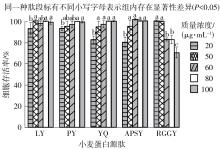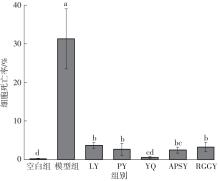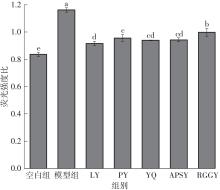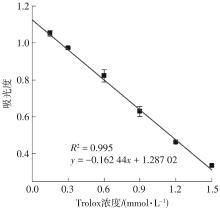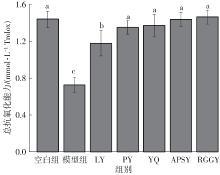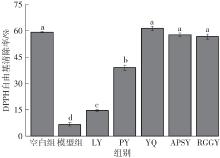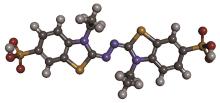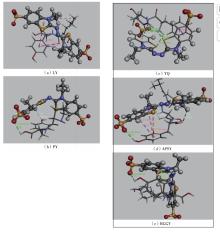| 1 |
ZHAO X C, ZHANG L, YU H X,et al .Curcumin protects mouse neuroblastoma Neuro-2A cells against hydrogen-peroxide-induced oxidative stress[J].Food Chemistry,2011,129(2):387-394.
|
| 2 |
LUSHCHAK V I .Free radicals,reactive oxygen species,oxidative stress and its classification[J].Chemico-Biological Interactions,2014,224:164-175.
|
| 3 |
YI G F, DIN J U, ZHAO F,et al .Effect of soybean peptides against hydrogen peroxide induced oxidative stress in HepG2 cells via Nrf2 signaling[J].Food & Function,2020,11(3):2725-2737.
|
| 4 |
刘文颖,冯晓文,程青丽,等 .大米低聚肽的制备和结构表征及体外抗氧化作用[J].华南理工大学学报(自然科学版),2021,49(11):47-56.
|
|
LIU Wenying, FENG Xiaowen, CHENG Qingli,et al .Preparation,structure characterization and in vitro antioxidant activity of rice oligopeptides[J].Journal of South China University of Technology (Natural Science Edition),2021,49(11):47-56.
|
| 5 |
NORDBERG J, ARNER E S J .Reactive oxygen species,antioxidants,and the mammalian thioredoxin system[J].Free Radical Biology and Medicine,2001,31(11):1287-1312.
|
| 6 |
吉正梅,张晓春,彭钰迪,等 .鸭胚源抗氧化肽TD12对HepG2细胞氧化应激损伤的保护作用[J].食品与发酵工业,2021,47(18):141-148.
|
|
JI Zhengmei, ZHANG Xiaochun, PENG Yudi,et al .Protective effect of duck embryo-derived antioxidant peptide TD12 on oxidative stress damage in HepG2 cells [J].Food and Fermentation Industries,2021,47(18):141-148.
|
| 7 |
KARAMI Z, PEIGHAMBARDOUST S H, HESARI J,et al .Antioxidant,anticancer and ACE-inhibitory activities of bioactive peptides from wheat germ protein hydrolysates[J].Food Bioscience,2019,32:100450/1-12.
|
| 8 |
ZHANG J, WEN C, LI C,et al .Antioxidant peptide fractions isolated from wheat germ protein with subcritical water extraction and its transport across Caco-2 cells[J].Journal of Food Science,2019,84(8):2139-2146.
|
| 9 |
LIU W Y, ZHANG J T, TAKUYA MIYAKAWA,et al .Antioxidant properties and inhibition of angiotensin-converting enzyme by highly active peptides from wheat gluten[J].Scientific Reports,2021,11(1):5206/1-11.
|
| 10 |
张燕,陈志飞,赵颂宁,等 .蛋清源抗氧化肽对HEK293细胞氧化应激损伤的抑制作用及机制[J].中国食品学报,2019,19(10):11-22.
|
|
ZHANG Yan, CHEN Zhifei, ZHAO Songning,et al .The anti-oxidative effects and mechanism of antioxidant peptides from egg white against oxidative stress injury in human embryonic kidney 293 cells[J].Journal of Chinese Institute of Food Science and Technology,2019,19(10):11-22.
|
| 11 |
ZHANG Q, CUI C, CHEN C Q,et al .Anti-proliferative and proapoptotic activities of Alpinia oxyphylla on HepG2 cells through ROS-mediated signaling pathway[J].Journal of Ethnopharmacology,2015,169:99-108.
|
| 12 |
LIU E Y, FANG L, FENG X W,et al . In vitro antioxidant and angiotensin I-converting enzyme inhibitory properties of peptides derived from corn gluten meal [J].European Food Research and Technology,2020,246:2017-2027.
|
| 13 |
MINE Y, MA F P, LAURIAU S .Antimicrobial peptides released by enzymatic hydrolysis of hen egg white lysozyme[J].Journal of Agricultural and Food Chemistry,2004,52(5):1088-1094.
|
| 14 |
WEN C, ZHANG J, ZHANG H,et al .Study on the structure-activity relationship of watermelon seed antioxidant peptides by using molecular simulations[J].Food Chemistry,2021,364:130432/1-7.
|
| 15 |
ZHANG J, LI M, ZHANG G,et al .Identification of novel antioxidant peptides from snakehead (Channa argus) soup generated during gastrointestinal digestion and insights into the anti-oxidation mechanisms[J].Food Chemistry,2021,337:127921/1-11.
|
| 16 |
LI C, ZHAN Y D, MA X Z,et al .B7-H4 facilitates proliferation and metastasis of colorectal carcinoma cell through PI3K/Akt/mTOR signaling pathway[J].Clinical and Experimental Medicine,2020,20(1):79-86.
|
| 17 |
LIU L, QIU T X, SONG D W,et al .Inhibition of a novel coumarin on an aquatic rhabdovirus by targeting the early stage of viral infection demonstrates potential application in aquaculture[J].Antiviral Research,2020,174:104672/1-13.
|
| 18 |
LU Q B, LIN X Y, WU J,et al .Matrine attenuates cardiomyocyte ischemia-reperfusion injury through activating AMPK/Sirt3 signaling pathway[J].Journal of Receptors and Signal Transduction Research,2021,41(1):488-493.
|
| 19 |
LU J M, LIN P H, YAO Q Z,et al .Chemical and molecular mechanisms of antioxidants:experimental approaches and model systems[J].Journal of Cellular and Molecular Medicine,2010,14(4):840-860.
|
| 20 |
NEMOTO S, TAKEDA K, YU Z X,et al .Role for mitochondrial oxidants as regulators of cellular metabolism[J].Molecular and Cellular Biology,2000,20(19):7311-7318.
|
| 21 |
YU D L, ZHA Y Y, ZHONG Z,et al .Improved detection of reactive oxygen species by DCFH-DA:new insight into self-amplification of fluorescence signal by light irradiation[J].Sensors and Actuators B:Chemical,2021,339:129878/1-9.
|
| 22 |
LIU X, FU Q, XU P,et al .Rapid determination of monopersulfate with bromide ion-catalyzed oxidation of 2,2′-azino-bis(3-ethylbenzothiazoline-6-sulfonic acid (ABTS)[J].Chemical Engineering Journal,2022,433:133551/1-8.
|
| 23 |
QIN X Y, ZHANG J T, LIU G M,et al .Structure and composition of a potential antioxidant obtained from the chelation of pea oligopeptide and sodium selenite[J].Journal of Functional Foods,2019,64:103619/1-8.
|
| 24 |
CHANG O K, HA G E, HAN G S,et al .Novel antioxidant peptide derived from the ultrafiltrate of ovomucin hydrolysate[J].Journal of Agricultural and Food Chemistry,2013,61:7294-7300.
|
| 25 |
SUN J, HE H, XIE B J .Novel antioxidant peptides from fermented mushroom Ganoderma lucidum[J].Journal of Agricultural and Food Chemistry,2004,52:6646-6652.
|
| 26 |
CHEN H M, MURAMOTO K, YAMAUCHI F,et al .Structural analysis of antioxidative peptides from soybean beta-conglycinin[J].Journal of Agricultural and Food Chemistry,1995,43:574-578.
|
| 27 |
SAITO K, JIN D H, OGAWA T,et al .Antioxidative properties of tripeptide libraries prepared by the combinatorial chemistry[J].Journal of Agricultural and Food Chemistry,2003,51:3668-3674.
|
| 28 |
GU R Z, LIU W Y, LIN F,et al .Antioxidant and angiotensin I-converting enzyme inhibitory properties of oligopeptides derived from black-bone silky fowl (Gallus gallus domesticus Brisson) muscle[J].Food Research International,2012,49:326-333.
|
| 29 |
ZHOU C, HU J, MA H,et al .Antioxidant peptides from corn gluten meal:orthogonal design evaluation [J].Food Chemistry,2015,187(15):270-278.
|
| 30 |
ZHU K X, ZHOU H M, QIAN H F .Antioxidant and free radical-scavenging activities of wheat germ protein hydrolysates (WGPH) prepared with alcalase[J].Process Biochemistry,2006,41(6):1296-1302.
|
| 31 |
张燕,魏汝君,潘风光,等 .蛋清源活性肽抗氧化及抗炎活性[J].食品科学,2018,39(13):153-158.
|
|
ZHANG Yan, WEI Rujun, PAN Fengguang,et al .Antioxidant and anti-inflammatory effects of bioactive peptides derived from egg white proteins[J].Food Science,2018,39(13):153-158.
|
| 32 |
WU R, HUANG J, HUAN R,et al .New insights into the structure-activity relationships of antioxidative peptide PMRGGGGYHY[J].Food Chemistry,2021,337:127678/1-8.
|
| 33 |
文超婷 .西瓜籽肽的抗氧化构效关系及其分子机制研究[D].镇江:江苏大学,2021.
|
| 34 |
YANG Q, CAI X, YAN A,et al .A specific antioxidant peptide:its properties in controlling oxidation and possible action mechanism[J].Food Chemistry,2020,327:126984/1-9.
|
